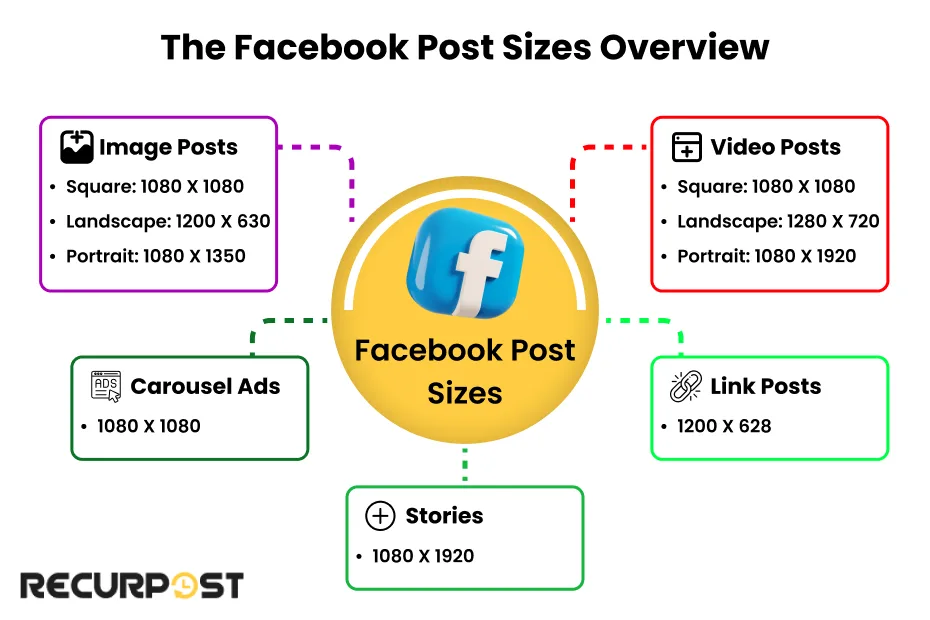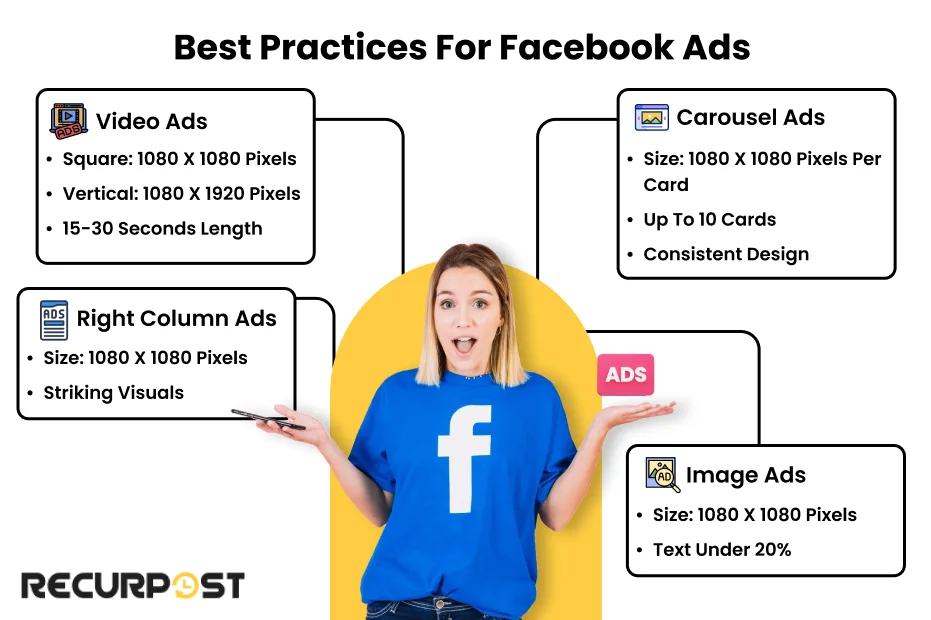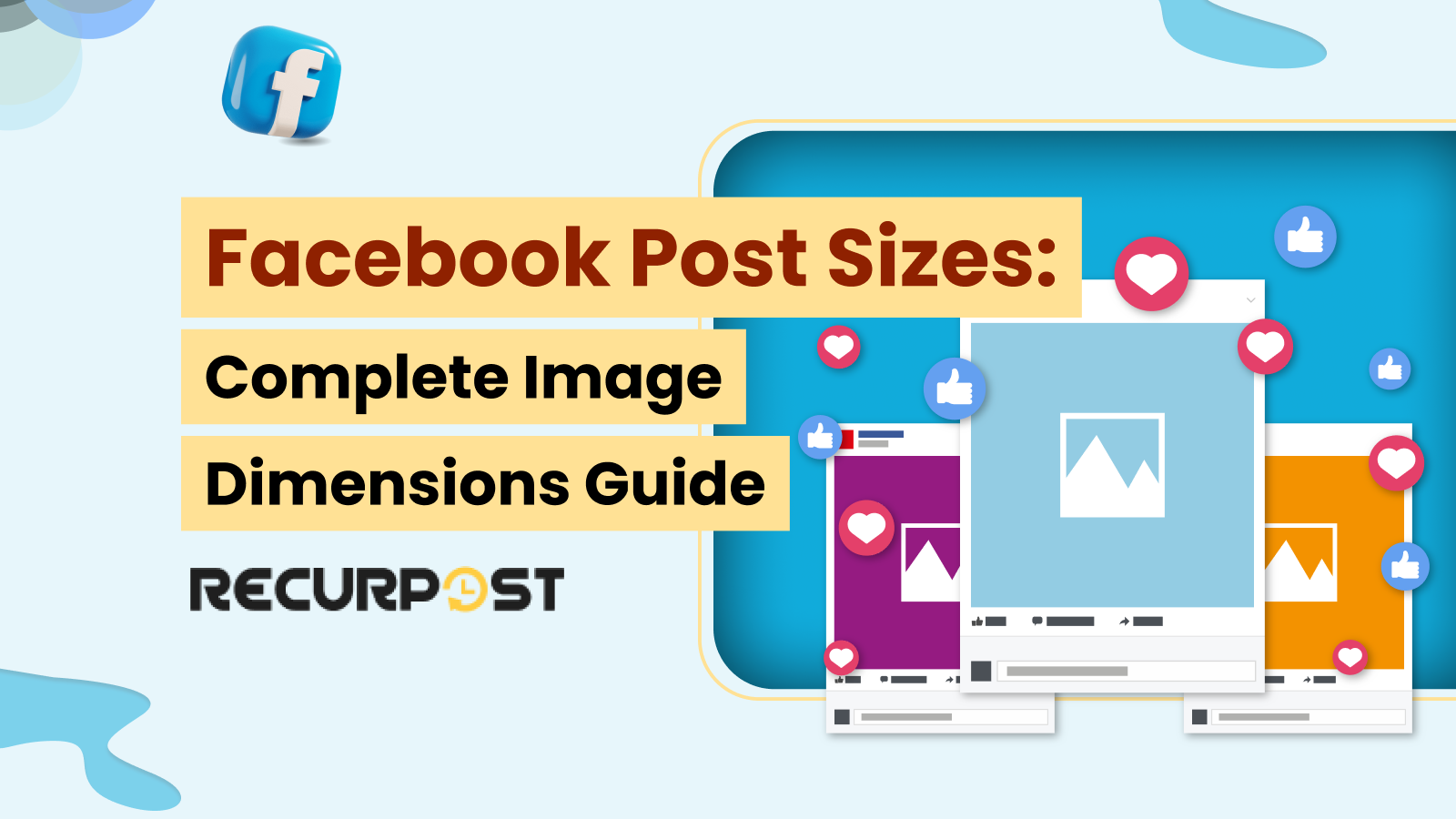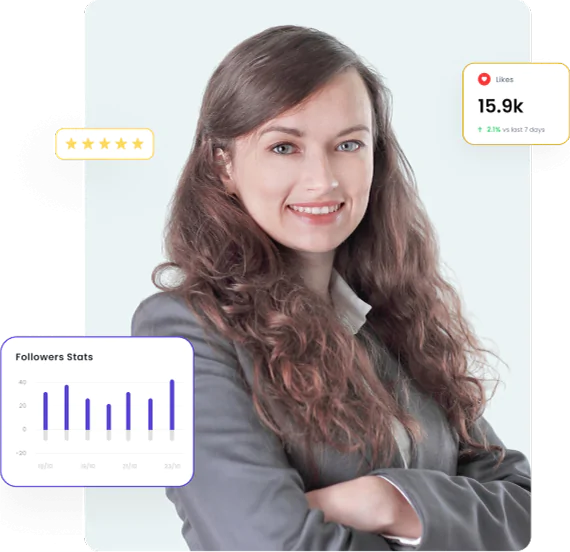Getting the right Facebook post sizes prevents awkward cropping of photos and videos. Poorly sized uploads can look unprofessional, hurt engagement, and even lead to rejected ads. Correct Facebook post sizes and dimensions approved by the Facebook algorithm, and keep your content sharp on both mobile and desktop. Sticking to the recommended pixels and aspect ratios ensures every image, video, or story displays as intended.
This 2025 guide covers all current Facebook image sizes, from feed posts to ads and stories, so your brand always looks polished across devices.
Find Various Answers to How to Post on Facebook to Improve Reach
Facebook Post Sizes Overview
Facebook post sizes decide how images and videos appear. Since layouts shift often, marketers must keep up with updated dimensions.
Below is a quick breakdown of the recommended Facebook image sizes across post types:

Facebook Image Posts
The standard square post size is 1080 x 1080 pixels (1:1 ratio). Landscape posts need 1200 x 628 pixels (1.91:1), which is also used for link sharing. Vertical posts use 1080 x 1350 pixels (4:5). Sticking to these social media image sizes prevents awkward cropping on mobile or desktop.
The core Facebook post ratios are: 1.91:1 (1200 x 628 pixels) for landscape and link posts, 1:1 (1080 x 1080 pixels) for square posts, and 4:5 (1080 x 1350 pixels) for vertical posts.
Facebook Link Posts
A link preview looks best at 1200 x 628 pixels. Using this size helps your preview image stand out in the News Feed and encourages clicks, driving social media engagement.
Facebook Video Posts
Dimensions depend on the format. Square videos work best at 1080 x 1080 pixels, landscape videos at 1280 x 720 pixels (16:9), and portrait videos or reels at 1080 x 1920 pixels (9:16). The video cover photo measures 820 x 312 pixels. These sizes keep videos sharp without black bars.
Facebook Carousel Ads
Each image or video should be 1080 x 1080 pixels (1:1 aspect ratio). This ensures all carousel frames are consistent and clean.
Facebook Stories
The ideal size is 1080 x 1920 pixels (9:16). Since interface icons appear at the top and bottom, avoid placing text in those zones to keep content visible.
Post at the Right Time, Every Time
Discover the best posting hours to get more reach and engagement.
⭐⭐⭐⭐⭐ “We doubled our Facebook engagement just by switching post times using this tool!” – Social Media Manager
Unlock Peak Posting Times – It’s Free
Facebook Profile & Cover Photo Sizes
Not all visuals show in the feed. Some, like the profile picture and cover photo, shape first impressions. These Facebook image sizes keep your branding sharp:
- Profile Picture: 170 x 170 pixels (shows as 128 x 128 on desktop with a circular crop).
- Page Cover Photo: 820 x 312 pixels.
- Group Cover Photo: 1640 x 856 pixels.
- Event Cover Photo: 1920 x 1005 pixels.
These dimensions keep branding consistent across personal profiles, business pages, groups, and events, making your presence look polished.
Best Practices for Facebook Ads
Great ads need more than the right Facebook post sizes. Strong visuals, balanced text, and clear design make them stand out. Here’s how:

Facebook Image Ads
Ads in the News Feed display best at 1080 x 1080 pixels (1:1). Keep text under 20% of the image for better visibility, even if the rule is no longer strict.
Facebook Video Ads
Use 1080 x 1080 pixels for square and 1080 x 1920 pixels for vertical. Aim for the first seconds to grab attention, and keep videos 15–30 seconds long for better engagement.
Facebook Carousel Ads
Each card should be 1080 x 1080 pixels. You can add up to 10 cards, each showing products or services. Consistent sizing keeps the ad polished.
Right Column Ads
These appear on desktop at 1080 x 1080 pixels. Since they’re smaller than feed ads, use bold images or sharp visuals to stand out.
Thinking How Do I Repost Things on Facebook?
Tips for Following Correct Facebook Post Sizes
- Always preview posts on mobile and desktop. This confirms your chosen Facebook post sizes look sharp on all screens.
- Run A/B tests to compare different Facebook post sizes and formats. This shows which ones connect better with your audience.
- Limit text on images. Let strong visuals carry the message so the post feels clear and uncluttered.
- Add popular hashtags on Facebook to boost reach and connect with active communities.
Learn How to Make a Facebook Post Shareable & Become an Expert
Technical Guidelines for Facebook Media
Beyond the right Facebook post sizes, files must follow Facebook’s technical requirements to avoid upload errors, compression issues, or playback problems:
- Maximum image file size: 8MB
- Maximum video file size: 4GB
- Maximum video length: 240 minutes
- Recommended resolution: 72dpi
- Maximum display dimension: 2048 pixels (a Facebook post size should not exceed this limit).
- Minimum image width: 500 pixels
Following these dimensions keeps content sharp, loads faster, and displays well across devices.
Tools for Facebook Posts & Ads
Manually resizing images and videos can be slow, even with clear Facebook post sizes and formats in mind. These tools make the job easier:
- Canva: Ready-made templates for Facebook posts, ads, and stories. Pick a layout, add your brand, and publish quickly.
- Adobe Spark: Like Canva, it includes social media templates. Great for creating visuals fast without starting from scratch.
- Facebook’s Image Resizer: A built-in tool for adjusting images to recommended dimensions, keeping posts aligned with current sizes.
- RecurPost: Lets you schedule posts and set up auto-reposting. Helps maintain a steady posting rhythm while keeping content aligned with the best time to post on Facebook.
Conclusion
Sticking to the right Facebook post sizes for images, videos, ads, and stories keeps content polished. Consistent Facebook post sizes also improve how your brand looks across devices. Staying current with Facebook’s size guidelines and using the right tools avoids display problems and helps your posts reach more people. Well-sized posts improve visuals and boost your impact across the platform.
FAQs
1. What is the optimal size for a Facebook post image?
The best size is 1200 x 630 pixels. It displays well on both desktop and mobile.
2. What is the ideal aspect ratio for Facebook post images?
The standard ratio is 1.91:1, which prevents cropping in the News Feed.
3. What is the Facebook post size in inches?
Facebook supports images up to 2048 x 2048 pixels, but 1200 x 630 pixels loads faster and looks cleaner.
4. Can I use square images for Facebook posts?
Yes, square posts at 1080 x 1080 pixels work well and take up more space on mobile screens.
5. What size should I use for Facebook event cover photos?
Use 1920 x 1005 pixels for event covers. It displays well on both desktop and mobile.
6. Does Facebook compress images?
Yes. Large images are compressed. To reduce quality loss, upload PNG for text-heavy graphics and JPEG for photos.
7. How do Facebook image sizes affect ads?
Ads that use the recommended Facebook post sizes and aspect ratios look more polished and draw higher engagement.
8. What happens if my image doesn’t match the recommended size?
Facebook crops it, which may cut off key visuals. Always resize before uploading.
9. Are Facebook post sizes different for desktop and mobile?
Yes. Facebook post sizes like 1200 x 630 pixels keep posts consistent across platforms. For mobile, square posts (1080 x 1080 pixels) or landscape (1200 x 628 pixels) work best.
10. What is the Facebook post size in inches?
At 300 DPI, the standard Facebook post size of 1200 x 628 pixels equals about 4 x 2.1 inches. For digital use, stick to pixels.

Ruchi Dhimar is a skilled content writer with 5 years of experience. She is passionate about crafting compelling narratives, specializing in writing content for different industries.





